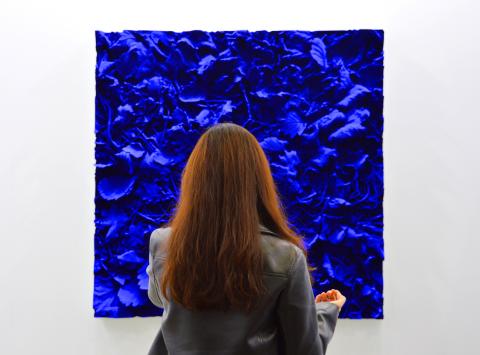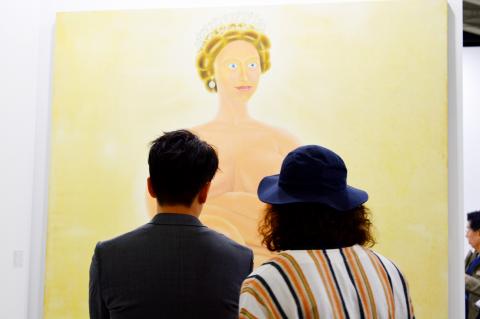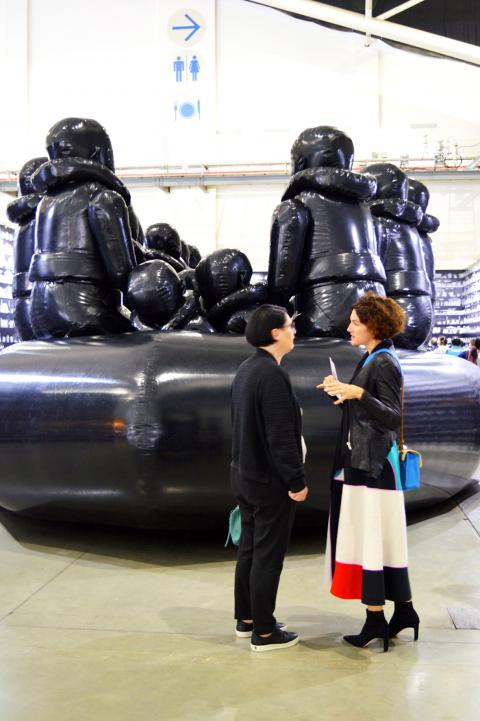“We hope to make Taipei Dangdai the most important event in the art scene around the world and in Asia,” was co-director Robin Peckham’s speech opening, speaking in Mandarin as a nod to the local market. Returning for a second year, Dangdai’s (台北當代) goal is to put Taipei on the map for the art world.
Asia is already a leading force in the global art market, and it is only expected to grow in importance in the upcoming years. However, which cities play a key role is constantly changing — especially in light of unstable business in Hong Kong over the last year.
“Taipei city is vibrant and collectors are hungry,” said Mariko Kawashima, director of Axel Vervoordt Gallery Hong Kong, one of the newcomers this year amongst 99 galleries — 23 of which have spaces in Taiwan.

Photo: Ella Csarno
Dangdai’s co-founder Magnus Renfrew said there is interest from galleries around the world in potentially joining next year.
COLLECTORS DO THEIR HOMEWORK
International galleries were impressed by the Taiwanese crowd.

Photo: Ella Csarno
“For a small country, it’s astonishing that there are so many collectors,” said Rachel Lehmann, co-owner of Lehmann Maupin. “They do their homework very well, and they collect in depth.”
It was a sentiment echoed by gallerist Sean Kelly.
“People here are very sophisticated, they understand quality,” Kelly said.

Photo: Ella Csarno
Though Kawashima said they are still learning about Taiwanese collectors, Kelly believes in bringing recognizable names and leading works to Taiwan. Indeed, the number of artworks from world-renowned artists like Marina Abramovic, Anish Kapoor, Ai Weiwei (艾未未) or Julian Opie have gone up considerably.
Galleries reported successful sales. David Zwirner sold multiple artworks within the first two hours of the fair, mostly to Taiwanese collectors. TKG+, the contemporary branch of Taiwanese Tina Keng Gallery (耿畫廊), said they were happy with the results, and, perhaps more importantly, made connections to new collectors.
NOT JUST FOR PROFIT
Backed by the Ministry of Culture, the Bureau of Foreign Trade and Taipei’s Department of Cultural Affairs, Dangdai provided a platform for many artists who were never presented in Taiwan before.
Oscar Murillo, co-winner of last year’s Turner Prize, who hosted a talk at the “Ideas” program of the fair, where he said that collaboration with a local institution is on the horizon for him.
Lehmann Maupin are also working with the Taipei Fine Arts Museum (臺北市立美術館) on a show about Erwin Wurm curated by Jerome Sans, and a solo exhibition with Tony Oursler at Kaohsiung Museum of Fine Art (高雄市立美術館).
THINKING LONG TERM
Shanghai and Hong Kong used to be absolute centers for the market in Asia, but international galleries have started diversifying, setting their foot in multiple cities. This mindset comes as political tension in Hong Kong caused a dip in the business of galleries last year.
“The art world is not isolated,” said Lehmann, “but with long-term strategies it’s easier to adapt to change.”
Arthur de Villepin, founder of Villepin, a gallery opening in Hong Kong in March added: “The energy of Hong Kong is beyond the political situation. The fact that it dilutes itself in the region is not a bad thing.”
Alongside his father, former French prime minister Dominique de Villepin, he hopes to open a salon-like space where long-term relationships with artists and collectors can be built.
“Cultural difference is richness to me,” he said.
Ultimately events like Dangdai continue to lay the foundations of Taipei as a safe haven for art. Taipei Dangdai will return again in January next year, promising a longer lineup.

We lay transfixed under our blankets as the silhouettes of manta rays temporarily eclipsed the moon above us, and flickers of shadow at our feet revealed smaller fish darting in and out of the shelter of the sunken ship. Unwilling to close our eyes against this magnificent spectacle, we continued to watch, oohing and aahing, until the darkness and the exhaustion of the day’s events finally caught up with us and we fell into a deep slumber. Falling asleep under 1.5 million gallons of seawater in relative comfort was undoubtedly the highlight of the weekend, but the rest of the tour

Youngdoung Tenzin is living history of modern Tibet. The Chinese government on Dec. 22 last year sanctioned him along with 19 other Canadians who were associated with the Canada Tibet Committee and the Uighur Rights Advocacy Project. A former political chair of the Canadian Tibetan Association of Ontario and community outreach manager for the Canada Tibet Committee, he is now a lecturer and researcher in Environmental Chemistry at the University of Toronto. “I was born into a nomadic Tibetan family in Tibet,” he says. “I came to India in 1999, when I was 11. I even met [His Holiness] the 14th the Dalai

Following the rollercoaster ride of 2025, next year is already shaping up to be dramatic. The ongoing constitutional crises and the nine-in-one local elections are already dominating the landscape. The constitutional crises are the ones to lose sleep over. Though much business is still being conducted, crucial items such as next year’s budget, civil servant pensions and the proposed eight-year NT$1.25 trillion (approx US$40 billion) special defense budget are still being contested. There are, however, two glimmers of hope. One is that the legally contested move by five of the eight grand justices on the Constitutional Court’s ad hoc move

Stepping off the busy through-road at Yongan Market Station, lights flashing, horns honking, I turn down a small side street and into the warm embrace of my favorite hole-in-the-wall gem, the Hoi An Banh Mi shop (越南會安麵包), red flags and yellow lanterns waving outside. “Little sister, we were wondering where you’ve been, we haven’t seen you in ages!” the owners call out with a smile. It’s been seven days. The restaurant is run by Huang Jin-chuan (黃錦泉), who is married to a local, and her little sister Eva, who helps out on weekends, having also moved to New Taipei